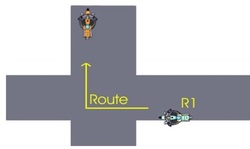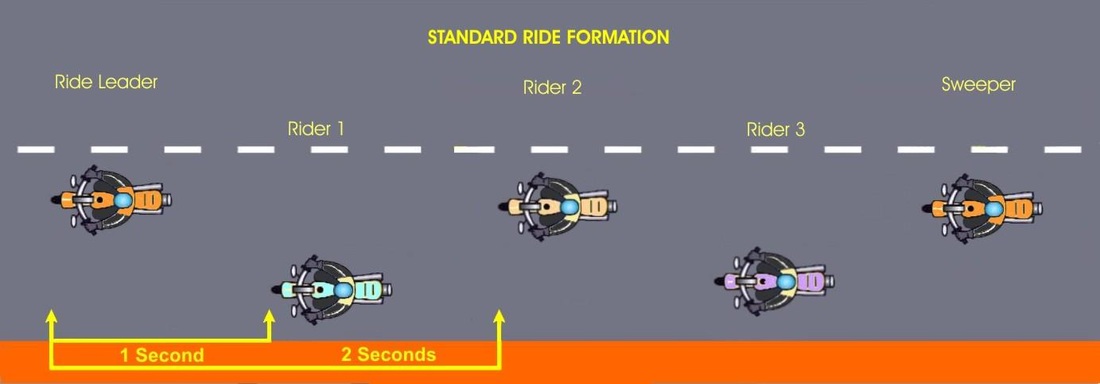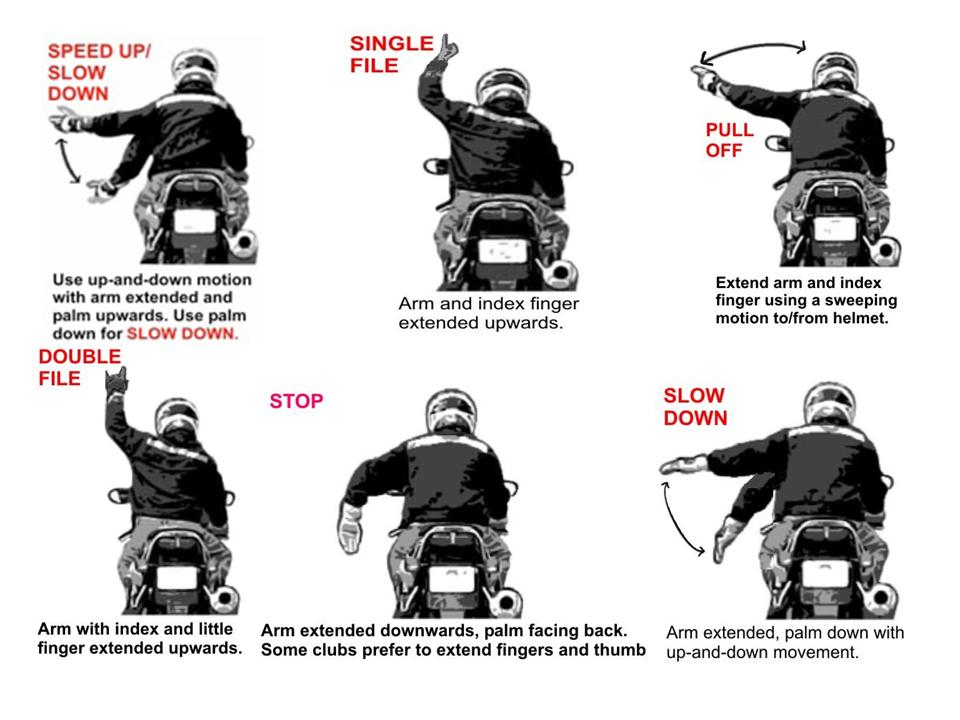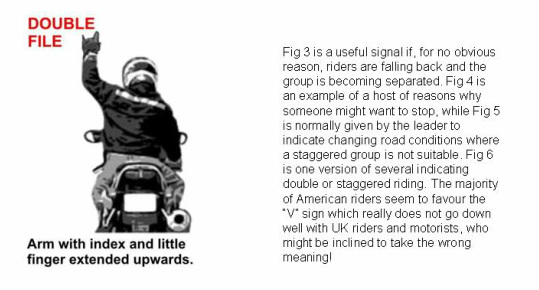_GROUP RIDING
_We do not intend to
teach experienced riders either the rules of the road or the “proper” method
for group riding. Most BK members will have a reasonable knowledge of both!
What I have done is simplify the usual recommendations for riding as a group,
and explain a few of the safer concepts. As a matter of good practice, the
Group Leader or Ride Captain will discuss the proposed route with all the
riders. This will include who the LEADER and SWEEPER will be, whether a
Drop-Off/ Marker System will be employed, the main Stopping/Rendezvous Points
and Junctions, and a Q&A session. I will not go into the equipment that
riders should wear or carry, as these should be second nature for all. So
first, let us look at the Standard Ride Formation. From the diagram below you
will notice that both the Leader and Sweeper should be wearing a hiviz tabard. This is especially important when employing the
Drop-Off/Marker System which will be explained further on. A staggered
formation is normal on motorways, dual carriageways and roads where the lanes
are wide enough to allow it. The Leader normally takes the outside third of the
lane while the next rider takes the inside third. An absolute minimum spacing
(see below) is one second between the two nearest riders, and two seconds
between every second rider. At faster speeds, this should obviously be
extended, particularly with less experienced riders and/or when road conditions
may warrant it. The staggered formation thus allows safe reaction to any
wobbles, obstructions etc. Pretty basic stuff!
_ On urban roads,
roads with narrow lanes, obstructions such as pedestrians, cyclists, parked
cars, buses & etc, the staggered formation is not normally suitable, and so
a single file formation should be employed. This means that the spacing should
also be extended and speed reduced accordingly. Crowded town centres will pose
specific problems, especially with traffic lights, junctions etc. In these
circumstances there is every opportunity for the group to become separated. The
best policy here (as indeed at all times), is for each rider to ride for
him/herself, obeying the traffic signals as he/she would when on their own. By
checking on his/her mirror on such occasions, each preceding rider will notice
that the person behind has been obliged to stop. By pulling in somewhere safe,
he/she can await their arrival. This system will eventually reach the Leader
who can do likewise. On the open road, especially where the surface conditions
are less than perfect, there are varying types of bends, junctions, possibly
agricultural vehicles and the usual differing types of traffic, the best
practice is to ride single file, leaving sufficient spacing for the unexpected.
The Leader will usually be the first to note a specific danger and will both
react and warn as necessary. Hand Signals will be discussed later.
Please note: The following images are adaptations made by a member of W2BK. The American systems that have often been taken as standard in the UK by various biking groups, are frequently not suitable for UK conditions and road systems. Our road markings, layouts and signs, as well as our Road Traffic Regulations, are not the same as those in the United States. So caution must be taken in order to avoid any confusion. It should also be acknowledged that the Group Riding practices discussed here, and indeed within other sites, are not necessarily contained within UK Law. Similarly, the hand signals depicted below, are adaptations for UK use, but again, are not contained in UK Law.
Groups and Clubs may use these images and texts as they wish, but we would ask that acknowledgement is made to W2BK.
Groups and Clubs may use these images and texts as they wish, but we would ask that acknowledgement is made to W2BK.
_DROP OFF SYSTEM

_The
Drop-Off/Marker System It can often happen - especially in larger groups – someone
drops well behind; perhaps they’ve had an engine failure, or worse, come off
for some reason. In any event, when the group becomes separated, the chances
are that riders at the front will be unaware, and following riders can easily
miss a vital turning. The Drop-Off System makes allowances for this. How? At
the start of the ride, all riders will be made aware that the Leader and
Sweeper are easily recognized by their tabards. This is vital for the system to
operate properly. Throughout the ride, the Leader and Sweeper NEVER change
their positions. Both will know the exact route with all the relevant stops etc.
Each rider, including the Leader, will periodically be checking on the group
behind using his/her mirrors. If someone has fallen behind unexpectedly, he/she
can slow and/or stop as necessary. Those at the back will automatically have
slowed or stopped according to the situation. This will eventually feed forward
to those at the front – providing they have been checking their mirrors! If we
now assume that the group has become very widely spaced for whatever reason,
the chances are that someone may take a wrong turn at some point,
particularly at a multijunction roundabout or unrealized junction. This has
been a frequent problem for many groups, but a problem that the Drop-Off System
has to a greater extent solved.



